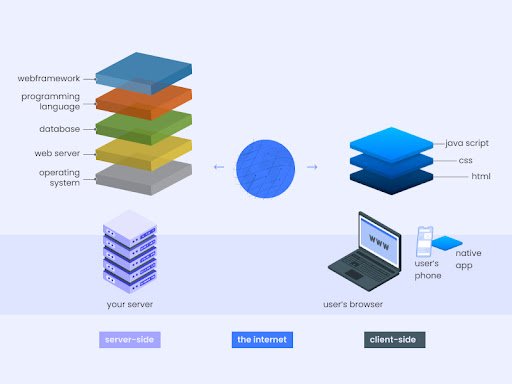Technology has had a profound impact on businesses; firms need to adopt new technologies and create a tech stack that improves their operations to stay competitive. But with many options available, it is challenging to know where to start.
This blog post discusses different components of a tech stack and how to put together a system that works for your business. We also stated tips on optimizing your tech stack for business growth and maximum efficiency.
Let’s first start by knowing what a tech stack is?
What Is Tech Stack and Businesses Should Use It?

A tech stack is a group of programs, software, or apps commonly used together in an organization. A tech stack might be general, like an LMS (Learning Management System) and CRM (Customer Relationship Management), or specific, like a content management system for an e-commerce site.
A technology stack combines software, programming languages, and infrastructure that helps create products or deliver services. The term stack refers to how one layer builds on top of another; you cannot have an app without some kind of foundation.
Most businesses use multiple stacks (or layers) of technology to build products or provide services. For example, your tech stack could include PHP as your primary programming language, MySQL as your database language, Amazon Web Services (AWS) as your cloud provider, GoDaddy for website hosting, and Advanced DNS for DNS resolution.
It would be considered one tech stack; countless others depend on what’s required by each business model and service offering.
Using Teck Stack which works well together can improve business by streamlining operations and offering more features at lower costs. Additionally, a perfect tech stack can increase growth opportunities, profit margins, and fewer outages when products crash.
In addition, to make the right use of the tech stack to drive business growth or build a tech stack suiting your business need, you can avail of a web development service.
Building A Right Tech Stack For Your Business Growth

Image Source: Creative Business
There are many ways to build a tech stack for business growth, and it just depends on what kind of business you’re running. Some companies need a very specific tech stack to run effectively, whereas others may be able to get away with something less stringent.
It all depends on your industry, budget, and what products and services you offer. Here view some examples of how to build your tech stack.
-
Know Why You Need It
Before you begin making changes in your business, you must have a clear idea of what you want your technology stack to do for your business. The specific functionality and services may differ depending on your goals, but having an overarching idea of why you need it will help guide which solutions make sense.
For example, if your goal is to scale up and grow, cloud-based solutions might be better than ones requiring custom hardware. In contrast, if security is one of your primary concerns, it might be best to stick with local servers instead of relying on third-party data centers for storage.
Knowing why you need a specific solution will also help during implementation as specific software and hardware can work better together than others.
-
Prioritize Strategy
Proper planning and strategy are crucial for any business. It’s essential to have a clear vision of where you want your company to go and an idea of how you’re going to get there. By creating a tech stack that prioritizes strategy, you can improve your business in many ways.
For example, by streamlining internal communications, you can ensure that everyone is on board with your vision and mission—which will help keep employees motivated and working toward common goals.
Plus, it’ll make it easier to hire new team members aligned with your company culture. Creating a tech stack that prioritizes strategy also makes it easier to implement processes throughout your organization—ensuring things run smoothly and efficiently.
You may even be able to increase employee productivity by making information accessible across multiple platforms. The possibilities are endless!
-
Right Programming Language
It’s not just about picking your favorite language or deciding which new framework will take over—it’s about determining which languages best complement each other and fit your business needs. First, assess your business needs; for example, do you need to store sensitive data? Then pick a few languages that meet those needs.
For example, if you need to store sensitive data and don’t want other people to see it, only use languages like Java and Python that have security built into them. If you need flexibility in software development, then choose C++ or JavaScript. If your business needs are simple, stick with more basic languages like HTML or CSS.
Remember: It’s not just about picking one language—it’s about picking several suitable for your project. Well, if in case you are including Java, Python, or other programming languages, then avail of Java application development services or
Python app development services. It will help you make efficient use of technologies in your business project development.
-
Pick The Right OS Platform
Before you start building, you’ll need to pick what operating system your application will run on. It could be straightforward like I want my app for all platforms, or it could be as complicated as I have legacy .NET code that I need to be integrated with Java running on a z/OS mainframe.
Your choice of the operating system will help determine what kind of frameworks you can use and will likely dictate how fast your application can execute. For example, native applications written in Swift will perform much better than those noted in Python and then be compiled into an iOS framework.
-
Think About Users
Your stack is useless if it doesn’t improve how your users engage with your product. A great way to make sure you’re building something that adds value for your customers is to create a prototype and get it in front of them as soon as possible.
It can help you find any major flaws or areas of confusion in your app or website and even tell you if it’s time to pivot to another idea. As Leonardo da Vinci said, Art is never finished, only abandoned.
So don’t be afraid to abandon what doesn’t work and go back again. You’re going to need to iterate over and over before you have a successful business on your hands. So, create a tech stack that does not affect the user experience but enhances it.
Teck Stack To Run A Long Plan In Future
The tech landscape is in constant flux. New programming languages come and go every few years, and software gets upgraded or retired every few months. Even hardware goes obsolete reasonably quickly, and as it does, it’s replaced by new operating systems and software. Because of all these changes, it’s very important to stay flexible when you start a business.
You never know when you might need to change your plan for integrating technology into your business if new tools become available that make better sense for your business.
It’s essential to keep abreast of what’s happening in tech to adapt your business model to improve performance and lower costs going forward.
Moreover, it’s essential to consider how your business will evolve as new technologies are introduced. Think about how you can integrate those technologies into your business model while they’re still relatively inexpensive. It will allow you to take advantage of them before they get too expensive (and thus less accessible).
Conclusion
Choosing a tech stack to improve business growth is one of the main decisions when setting up your new business or planning to develop software. A solid foundation with strong and knowledgeable partners helps avoid problems down the road while providing room for growth.
Understanding how your technology works together will help you decide what can and should be integrated and what needs to be developed internally.
It’s vital to balance future-proofing with short-term use to avoid spending too much on technologies that won’t benefit you today—and in five years. As per my research, I found the pointers stated above really helpful for making your task easier when choosing your tech stack.
To build the right and productive tech stack for your business, avail of information technology consulting services from one of the best software development firms.












